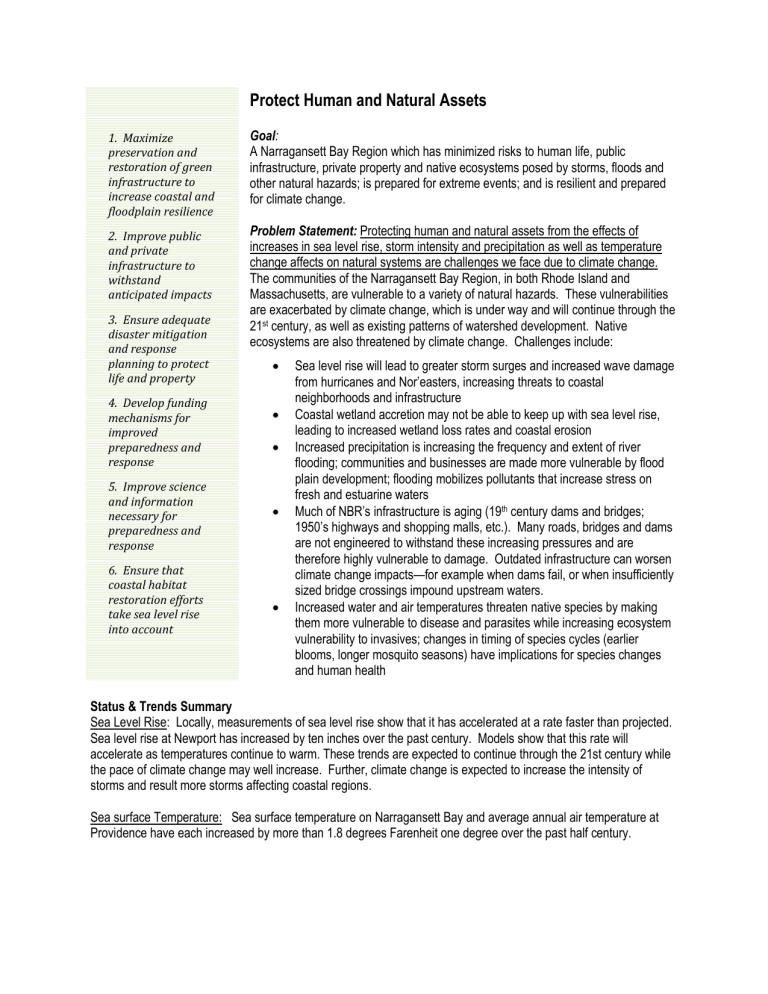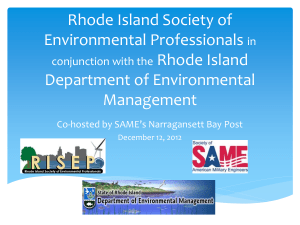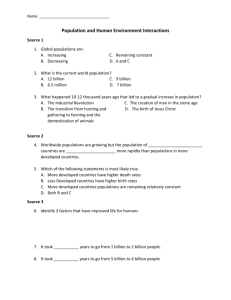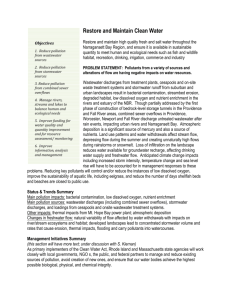Protect Assets sxn 111611 - Narragansett Bay Estuary Program
advertisement

Protect Human and Natural Assets 1. Maximize preservation and restoration of green infrastructure to increase coastal and floodplain resilience Goal: A Narragansett Bay Region which has minimized risks to human life, public infrastructure, private property and native ecosystems posed by storms, floods and other natural hazards; is prepared for extreme events; and is resilient and prepared for climate change. 2. Improve public and private infrastructure to withstand anticipated impacts Problem Statement: Protecting human and natural assets from the effects of increases in sea level rise, storm intensity and precipitation as well as temperature change affects on natural systems are challenges we face due to climate change. The communities of the Narragansett Bay Region, in both Rhode Island and Massachusetts, are vulnerable to a variety of natural hazards. These vulnerabilities are exacerbated by climate change, which is under way and will continue through the 21st century, as well as existing patterns of watershed development. Native ecosystems are also threatened by climate change. Challenges include: 3. Ensure adequate disaster mitigation and response planning to protect life and property 4. Develop funding mechanisms for improved preparedness and response 5. Improve science and information necessary for preparedness and response 6. Ensure that coastal habitat restoration efforts take sea level rise into account Sea level rise will lead to greater storm surges and increased wave damage from hurricanes and Nor’easters, increasing threats to coastal neighborhoods and infrastructure Coastal wetland accretion may not be able to keep up with sea level rise, leading to increased wetland loss rates and coastal erosion Increased precipitation is increasing the frequency and extent of river flooding; communities and businesses are made more vulnerable by flood plain development; flooding mobilizes pollutants that increase stress on fresh and estuarine waters Much of NBR’s infrastructure is aging (19th century dams and bridges; 1950’s highways and shopping malls, etc.). Many roads, bridges and dams are not engineered to withstand these increasing pressures and are therefore highly vulnerable to damage. Outdated infrastructure can worsen climate change impacts—for example when dams fail, or when insufficiently sized bridge crossings impound upstream waters. Increased water and air temperatures threaten native species by making them more vulnerable to disease and parasites while increasing ecosystem vulnerability to invasives; changes in timing of species cycles (earlier blooms, longer mosquito seasons) have implications for species changes and human health Status & Trends Summary Sea Level Rise: Locally, measurements of sea level rise show that it has accelerated at a rate faster than projected. Sea level rise at Newport has increased by ten inches over the past century. Models show that this rate will accelerate as temperatures continue to warm. These trends are expected to continue through the 21st century while the pace of climate change may well increase. Further, climate change is expected to increase the intensity of storms and result more storms affecting coastal regions. Sea surface Temperature: Sea surface temperature on Narragansett Bay and average annual air temperature at Providence have each increased by more than 1.8 degrees Farenheit one degree over the past half century. Precipitation: Average precipitation has increased by more than 11.8 inches per year over the past century, an increase in the range of 16-30 percent, and river flow is also clearly increasing, although the variability is such that a figure cannot be given. Coastal Erosion: Coastal beaches in the Narragansett Bay Region are subject to erosion rates that average greater than three feet per year in some places—a rate that can be substantially exceeded during a single major storm event. Dam Hazards: There are estimated to be more than a thousand dams on the region’s rivers and streams, ranging from small stone weirs to relatively large structures classified as “significant” and “high hazard” dams—those with the potential to cause death or extensive property damage in the event of failure. Many of these structures pose risks of failure in the event of a flood; this problem will increase greatly over the coming decades, as regional precipitation continues to increase and the dams—most of which date to the early 19th century—continue to deteriorate. Left in place, many of the dams have ongoing environmental impacts—preventing the movement of fish and wildlife; raising stream temperatures; and displacing riverine habitat. Management Initiatives Summary Work/projects by RIEMA, RISG & CRC, CRMC policy changes, local code changes Indicators to Measure Change Sea level rise rate; coastal shoreline water levels; coastal erosion rates; air temperature; precipitation levels; river/stream levels; river/stream temperature Priority Actions for Near Term Implementation (drawn from tables below; add timeframes) 1. Protect and restore watershed and riverine natural resources like wetlands and riparian areas so that they can continue to provide cost-effective protection. 2. Remove dams where practicable; where dams must be retained, ensure that high and moderate hazard dams are fully maintained 3. Develop and implement natural hazard mitigation and adaptation plans for publicly-owned facilities 4. Adopt more stringent building standards, flood ordinances, permitting processes, and best practices to improve resilience of private structures in coastal flood zones and to guide development away from high hazard zones 5. Design stormwater treatment facilities and green stormwater infrastructure to have adequate capacity for increased, intensified flow resulting from climate change 6. Develop funding mechanisms for infrastructure retrofits for affected utilities and structures 7. Continue to develop accurate inundation models for coastal and riverine floodplains Protection of Human & Natural Assets 1. Maximize preservation and restoration of green infrastructure to increase coastal and floodplain resilience 1.1 Use state and local permitting processes and adaptive restoration programs (e.g.,living shorelines) to protect natural coastal features like salt marshes and beaches as well as coastal shoreline processes so that they can continue to provide cost-effective coastal protection. 1.2 Protect and restore watershed and riverine natural resources like wetlands and riparian areas so that they can continue to provide cost-effective protection. 1.3 Remove dams where practicable; where dams must be retained, ensure that high and moderate hazard dams are fully maintained 1.4 Develop and improve dam condemnation mechanisms for purposes of removal in R.I. and Mass. RIDEM, RICRMC, MADCR, MACZM, municipalities, RIDEM, RICRMC, MADCR, MACZM, municipalities, federal agencies RIDEM, RICRMC, MADCR, MACZM, municipalities, state emergency mgmt. agencies RIDEM, RICRMC, MADCR, MACZM, municipalities, state emergency mgmt. agencies 2. Improve public and private infrastructure to withstand anticipated impacts 2.1 Improve dam inspection and maintenance requirements and enforcement 2.2 Develop and implement natural hazard mitigation and adaptation plans for publicly-owned facilities 2.3 With transportation departments, develop programs to examine flood capacity of bridges and other public structures; begin planning and funding for improvements 2.4 Reduce vulnerability of communities to flooding through implementation of stronger flood plain management policies including setbacks, elevation, construction and utility requirements, etc. 2.5 Incorporate advancements in coastal hazards science into state and local policies. 2.6 Adopt more stringent building standards, flood ordinances, permitting processes, and best practices to improve resilience of private structures in coastal flood zones and to guide development away from high hazard zones 2.7 Update state building code freeboard requirements and design life standards as new scientific information becomes available 2.8 Design stormwater treatment facilities and green stormwater infrastructure to have adequate capacity for increased, intensified flow resulting from climate change RIDEM, RICRMC, MADCR, MACZM, municipalities, state emergency mgmt. agencies RIDEM, RICRMC, MADCR, MACZM, municipalities, state emergency mgmt. agencies, RISG RIDOT, MADOT, RIDEM, RICRMC, MADCR, MACZM, municipalities, state emergency mgmt. agencies state emergency mgmt. agencies, RISG RIDEM, RICRMC, MADCR, MACZM, municipalities, RISG RIDEM, RICRMC, MADCR, MACZM, municipalities RIDEM, RICRMC, MADCR, MACZM, municipalities, state emergency mgmt. agencies, RISG RIDOT, MADOT, RIDEM, RICRMC, MADCR, MACZM, municipalities, emerg. mgmt. agencies 2.8 Assess the effects of salt water intrusion on coastal onsite wastewater treatment systems RIDEM, RISG, URICE, Mass. universities 3. Ensure adequate disaster mitigation and response planning to protect life and property 3.1 Develop and update local natural hazard mitigation plans (floods and coastal storms), increase the capacities required to implement them, and to improve local responses to coastal and inland flooding events 3.2 Develop a pre-disaster checklist for municipalities in order to facilitate federal disaster funding Emergency mgmt. agencies, municipalities, RIDOP, Mass Regional Planning, RISG Emergency mgmt. agencies, municipalities, RIDOP, Mass Regional Planning, RISG 4. Develop funding mechanisms for improved preparedness and response 4.1 Develop additional funding for dam inspection, maintenance and removal—examine development of fees on existing reservoirs to create dam management fund 4.2 Develop/leverage funding for acquisition of properties most vulnerable to climate change impacts 4.3 Develop funding mechanisms for infrastructure retrofits for affected utilities and structures. RIDEM, RICRMC, MADCR, MACZM, municipalities, state emergency mgmt. agencies RIDEM, RICRMC, MADCR, MACZM, municipalities, state emergency mgmt. agencies, RISG RIDEM, RICRMC, MADCR, MACZM, municipalities, state emergency mgmt. agencies 5. Improve science and information necessary for preparedness and response 5.1 Revisit science and identify research needs to better assess sea level rise and precipitation rates 5.2 Use data generated by regional Light Detection and Ranging (LIDAR) topographic surveys and high-resolution bathymetry databases to support floodplain mapping, sea-level rise and storm surge modeling 5.3 Continue to develop accurate inundation models for coastal and riverine floodplains RIDEM, RICRMC, MADEP, MACZM, universities, federal agencies RIDEM, RICRMC, MADCR, MACZM, municipalities, state emergency mgmt. agencies, RISG RIDEM, RICRMC, MADCR, MACZM, municipalities, state emergency mgmt. agencies, RISG 6. Ensure that coastal habitat restoration efforts take sea level rise into account 6.1 Develop adaptation plans for wetland migration to include protection of adjacent upland areas RIDEM, RICRMC, MADCR 6.2 Support/expand as practicable Living Shorelines program RIDEM, RICRMC, MADCR










